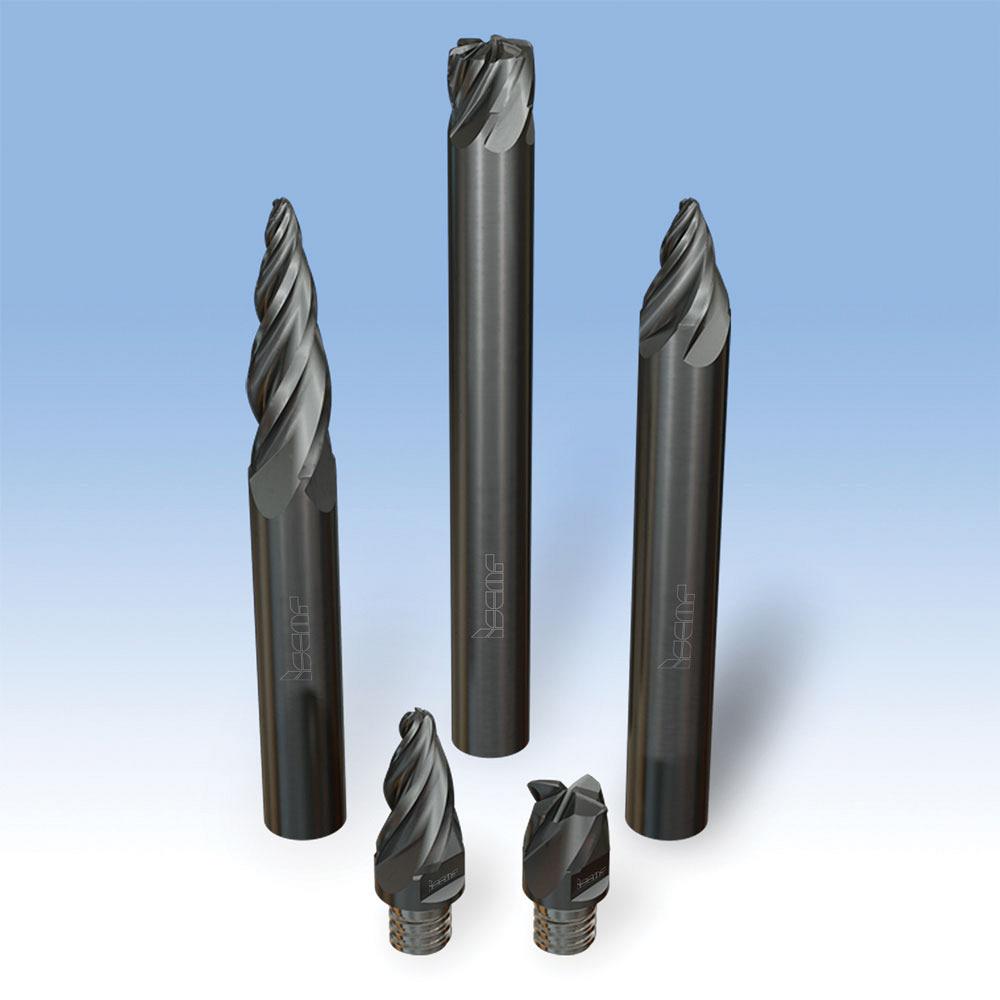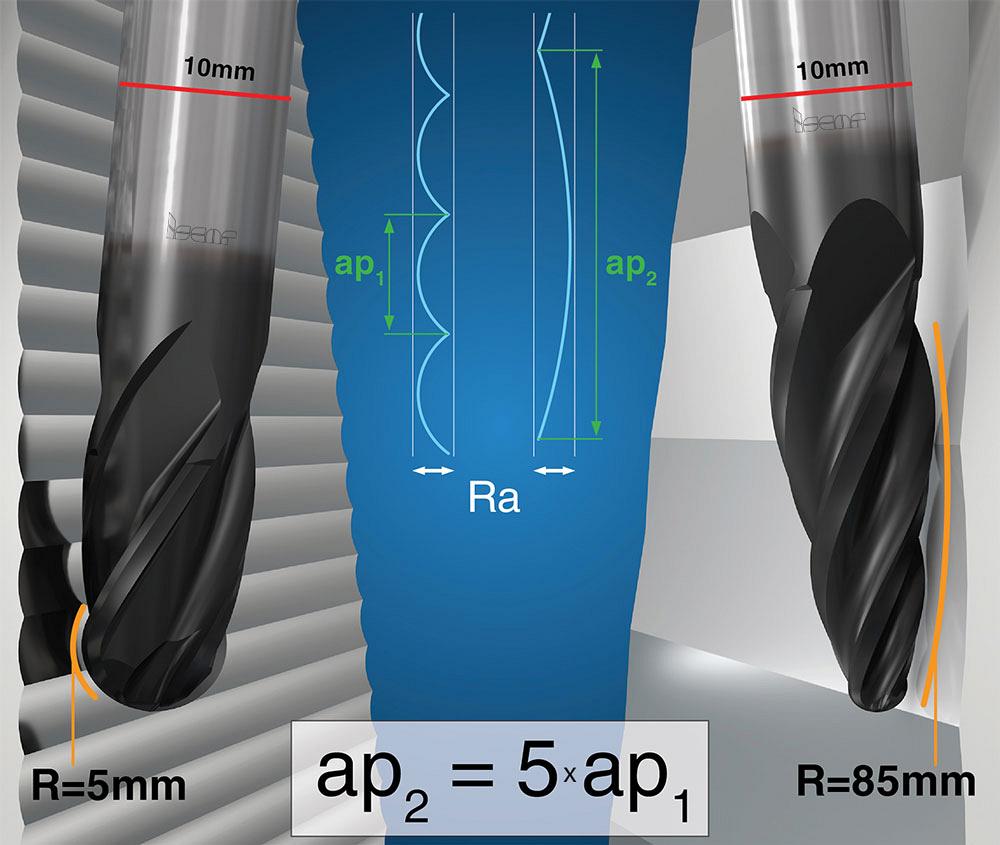Technical Advisor
- FMA
- The Fabricator
- FABTECH
- Canadian Metalworking
Barrel milling cutters shape a new milling trend
New role for barrels
- By Andrei Petrilin
- April 5, 2021
- Article
- Cutting Tools

Because of the complicated shape of its cutting edges, a barrel end mill is designed as a throwaway tool. When the wear limit is reached, the entire carbide end mill simply becomes waste. In contrast to solid tools, the Multi-Master design of exchangeable heads is a cost-effective use of cemented carbide materials. Also, numerous shanks, reducers, and extensions are available.
End mills with a cutting edge that looks like a segment of a large-diameter arc were introduced approximately 25 years ago. Because the shape of the cutting edge looks like a barrel’s profile, the tools became known as barrel milling cutters, or in shop talk, often simply as barrels.
At first the use of these barrel milling cutters was limited to just a few specific applications, such as machining the 3D surfaces of complex dies and turbomachinery components. However, recent advances in 5-axis machining and CAM systems have significantly expanded the role of barrel milling cutter applications.
This is because the design principle of having a cutting edge with a large-diameter arc has been used successfully in other types of milling cutter, such as tools for high-feed milling (HFM). The concept provides a toroidal cutting geometry that helps ensure productive rough machining at very high feed rates because of the tool’s chip-thinning effect.
Finish Your Work
Unlike high-feed milling tools, though, barrel end mills are not intended for roughing but for finish and semi-finish machining of 3D surfaces with low stock removal.
Traditionally, ball-nose and toroidal cutters perform these machining operations. However, the large-diameter arc of the barrel end mill cutting edge results in a substantial reduction of the cusp height generated between passes machined by a ball-nose or toroidal cutter.
Another advantage of this type of cutting edge versus ball-nose and toroidal cutters is a significant increase in the distance between passes (the stepover or a stepdown, depending on the direction of the cutter displacement after every pass) that is at least five times greater, without any degradation of the surface finish parameters.
This means that the number of passes and, subsequently, machining time can be noticeably reduced. Increasing the distance between passes also improves tool life and, therefore, lowers tool cost per part.
Shape Changes
The classic barrel shape in these end mills has undergone some changes to make these cutters more versatile. Combining a ball-nose tip with peripheral large-arc cutting edges creates a multipurpose cutting oval, which facilitates the use of a barrel end mill as a ball-nose milling tool.
In taper end mills, transforming the profile of a major cutting edge into a large-arc segment generates another cutting oval -- a taper barrel. When compared with a common taper end mill, the taper barrel provides pinpoint contact between the major cutting edge and the machined surface that reduces accuracy errors and helps prevent recutting of a produced shape. The taper shape also contributes to reducing tool overhang – an important factor for improving tool performance.
Barrel and oval end mills are used mainly for cutting side surfaces. If machining of a complex bottom surface is required, a lens-shape end mill is a good alternative. This tool has barrel-shape cutting edges on its end surface to help ensure milling with a large stepover can be performed.
Barrel end mills -- classic barrel-, oval-, and lens-shaped cutters – are efficient tools for machining 3D surfaces. Nevertheless, for a long time the complexity of CNC programming for applying barrel end mills was a constraining factor in actively integrating these tools into the appropriate branches of the metalworking industry.
The growing use of 5-axis machine tools and the latest progress in CAM software have changed the situation dramatically, and today we see intensive use of these tools in manufacturing numerous parts with geometrically complex surfaces. The main consumers of these barrels are manufacturers of aerospace, die and mould, medical, turbine, and compressor components.
Cutting tool companies in turn have strengthened their efforts to develop and manufacture more advanced barrel end mill designs to meet increased customer demands.
Currently barrel milling cutters are not in incredibly high demand by the metalworking industry because they are intended for very specific parts, and the effective application of the cutters requires highly engineered, multiaxis machines and, especially important, advanced CAM systems. However, advanced workpiece manufacturing technologies (such as metal injection moulding, 3D printing, investment casting, and close-tolerance forging), innovative machine tools, and a leap in digitizing of manufacturing will increase the needs for finishing complex surfaces with minimum machining stock.
Iscar estimates that barrel end mill consumption in the metalworking industry will increase exponentially, and cutting tool manufacturers should be shaping up to what is evidently a promising new industrial trend.
Andrei Petrilin is technical manager for Iscar Tools, 2100 Bristol Circle, Oakville, Ont. L6H 5R3, 905-829-9000, www.iscar.ca.

Iscar offers oval- and lens-shape end mills in diameters from 8 to 16 mm and 0.312 to 0.500 in. In addition to their availability in solid-carbide design configurations, new barrel end mills have been manufactured with exchangeable carbide heads with Multi-Master threaded adaptation. With this design, a worn head can be changed without withdrawing a tool from the machine spindle.
About the Author
Andrei Petrilin
2100 Bristol Circle
Oakville, L6H 5R3 Canada
905-829-9000
Related Companies
subscribe now


Keep up to date with the latest news, events, and technology for all things metal from our pair of monthly magazines written specifically for Canadian manufacturers!
Start Your Free Subscription- Trending Articles
Sustainability Analyzer Tool helps users measure and reduce carbon footprint

Enhance surface finish with high-speed machining

Equispheres secures $20 million investment round

Solid carbide drills produce precision holes in short chipping materials

Okuma announces new personnel appointments

- Industry Events
Automate 2024
- May 6 - 9, 2024
- Chicago, IL
ANCA Open House
- May 7 - 8, 2024
- Wixom, MI
17th annual Joint Open House
- May 8 - 9, 2024
- Oakville and Mississauga, ON Canada
MME Saskatoon
- May 28, 2024
- Saskatoon, SK Canada
CME's Health & Safety Symposium for Manufacturers
- May 29, 2024
- Mississauga, ON Canada
















